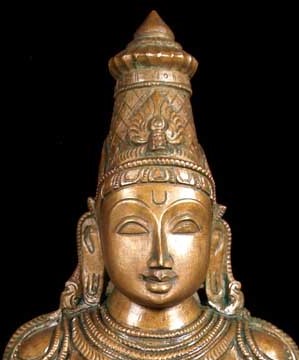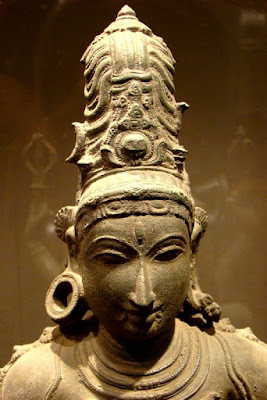Maulis/ Makutas/Mukutas/Head Gears/Coronets/Diadems of Hindu Gods and Godess
Ushnisha Bhushana / Shriobestana
Kirita Mukuta
Mukuta means 'Crown' in sanskrit. Kirti means' Glory'. Kirita Mukuta is a conical crown or cylindircal crown with lot of ornamentation and adorned with gem stones of glory. The centre of front side of the crown has a jewel or a central motiff. The rest of the crown are covered with small designs. Kirita Mukuta symbolises royalty and adorns various forms of Vishnu and Surya. The crown has appearance of Taranga (ie waves). The base of Kirita Mukuta must be curved like a Ardha-Chandra(Crescent shaped)just above the forehead. The height of the Kirita Mukuta should be two or three times the length of the wearer's face. It symbolises the superior nature of the wearer and he has many subordinates to do his work. Kirita Mukuta can be worn by Chrakavarthis who conquered beyond seas.
Karanda Mukuta
Mukuta means 'Crown' in sanskrit. Karanda means 'Bowl' in sanskrit. Karanda Mukuta is basket shaped crown or bowl shaped crown with short height and small size.Karanda Mukuta is a coronet meaning a small or relatively simple crown, especially as worn by lesser royalty and peers or peeresses. Karanda Mukuta is indication of subordination in status among pantheon of gods.
Usually female dieties or demigods and yakshas are provided with Karanda Mukutas. It has three or five or seven round basket shaped tiers. The lowest tier is studded with jewels and has a golden band. The topmost tier is surmounted by a śikhamaṇi or crest-jewel. The width of Karanda Mukuta should be only one half or one third less than that at its base.
Jata Mukuta
Jata Mukuta is the crown like formation
when matted hair is ornamentally coiled or twisted to form a tall crown. Jata
Mukuta is crown made up of Jata (ie matted locks) which are twisted into
encircling braids of spiral curls and tied into a knot looped at the top. It is
held in place by a patta(ie band). An milky exudation of certain trees are
applied to prevent dirt and dust sticking to it and can be convenient and easy
and hassless to manage. Jata Mukutas is for Sages and Gods like Shiva, Brahma,
Rudra and also consorts of Shiva.
They should be three Angulas in height. on the four sides there must be four puris. In the middle it must be held by seven holed Makara Kuta. on each side there has to be patra Kuta and on the back side a ratna kuta. The breadth of the Ushnisha must be ten angulas at the top and at the base it should be same as the wearer's face. In Jata Mukuta ,Shiva has to be adorned whit moon on left or right side and cobra on the left side. Jata Makutas are infact five braids of matted hairs which are taken and coiled into a knot for threee inchesin height by coiling them into tree loops the rest of braids are being bound and taken through to be left hanging on both sides. Jata Makuta is for Shiva, Brahma and Manonmani
Jata Mukuta with Siras chakra
Natrajar statue is shown to have matted hair flowing horizontally is a variant of Jata Mukuta
Jata Bandha
Here the matted hairs are tied together. The saints and ascetics follow this hairdo style. It looks like a basket tied around the head. This hairstyle can be seen in the images of
devotees and also in one form of Shiva where he wanders around with a begging
bowl.
Jata Mandalam
The matted locks aare spread in all directions like rays of a sun and resembles the constellation spread across the universe and hence called as Jata Mandalam. Shiva as Bhikshander has Jata Mandalam coiffure.
Sirastikaram
Jata Bhara
Shiva as rishababhavana his head in aturban of matted snake coils
Siris chakra on the back side
Jwala Mukuta
In few case the matted locks spread out in a fan like fashion like a flame and it is called as Jwala Mukuta. We can see in Godess Kali and dance pose of Lord Shiva, Agni Bhairavar
Kali -Jwala Muktua
Kesabandha
Kesabandha is a hair arrangement where hair is combed and tied in a knot at the top of the head with a band over in the middle and a wheel ornament on either side. . Kannapa Nayannmar with a kesabandha in ThiruValangadu about 10 th century AD.
Many varieties of the knot are
applied and sometimes floral garlands are fixed around it. KesaBandha is potrayed in most Saraswathi sculpture. Even Lakshmi adopts a similar Kesa
Bandha hairdo which is called Kuntala and it is also used to potray emperor
wife’s hair do

Sirastraka is for generals who serve the King.
Dhammilla is a type of coiffure where hair is arranged into
a bun and it is worn by wives of
Mandalikas or governors.It is also called as Kabari or KesaVesa.
Head of Parvati from Ahichhatra, U.P. 5th century
Alaka Chudaka is worn by torch bearing women or wives of
sword bearers and shield bearers.



























































Comments
Post a Comment